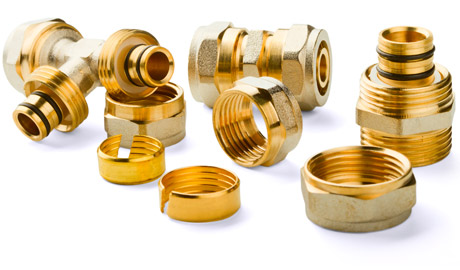New Rules for New Copper Alloys
New Rules for New Copper Alloys


A federal law to further reduce the amount of lead in drinking water has manufacturers of copper alloy plumbing fixtures, fittings and valves replacing their products with ones manufactured with new copper alloys that do not contain lead. But the peculiarities of the market and a new amendment to the Safe Drinking Water Act allow the original fittings to still be used in industrial applications while those charged with setting technical standards work to catch up.
Early this year, President Obama signed into law the Reduction of Lead in Drinking Water Act, a measure that defines "lead free" as not containing more than 0.2% lead when used with respect to solder and flux, and not more than a weighted average of 0.25% lead when used with respect to wetted surfaces of pipes and pipe and plumbing fittings and fixtures. It also establishes a formula to calculate the weighted average of lead content in a pipe or plumbing fitting or fixture.
As a practical matter, manufacturers had already begun selling new lead-free pipe, valvesand fittings because California, Vermont, and Maryland beat the federal government to the punch and had already passed similar legislation mandating the new lead-free products. But fittings and valves commonly used in low-pressure, low-temperature plumbing settings are also often used in high-pressure, high-temperature steam systems. The new lead-free products are giving standards-setting organizations pause because the lead-free alloys have not been fully vetted for high-pressure use.
"The data is not there to support high-pressure, high-temperature" alloys, says Mark Clark, a codes and standards engineer with NIBCO INC., Elkhart, IN. "There are already manufacturers putting steam ratings on items produced from unproven lead-free alloys."
Clark also is a member of ASME's B-16 committee that handles valves and fittings. The committee now is beginning work to include new alloys into standards for low-pressure plumbing, he says.
Some of the common alloys used in fittings and valves include C37700, C84400, C83600, and C92200, he says. All are identified as being acceptable for use at temperatures of 400 °F or higher, and pressures of 200 psi or higher. But all of them have a lead content greater than the 0.25% maximum limit set by the federal and state bill that are now in effect.
Clark emphasizes that the old fittings and valves remain in compliance for high-pressure industrial systems. The point is that neither new nor old fittings can be used interchangeably any more. "That's where the scramble is at," says Clark.
Most, if not all, manufacturers now supply both types of valves and fittings. But it can become a complex and more costly process if manufacturers have to produce essentially the same product using current methods and materials in addition to different alloys and new tooling, patterns, and core boxes. According to the U.S. Environmental Protection Agency, the main sources of lead in drinking water are through corrosion of household plumbing systems and erosion of natural deposit. Lead can leach into water from pipes, solder, fixtures, faucets, and fittings. The agency estimates that 10%-20% of human exposure to lead comes through drinking water. For infants who are primarily fed mixed formula, the agency estimates exposure rates of 40%-60%.
NIBCO and other manufacturers had anticipated more stringent regulations earlier in the decade. NIBCO's lead-free HydroPure line introduced in the early 1990s simply "did not gain market acceptance," notes Clark. The company monitors regulatory developments and continues to offer lead-free products.
"But from a manufacturing standpoint, the question is, can we expand the use of lead-free alloys beyond water applications or continue to maintain a dual inventory?" he says. "How is a manufacturer to monitor the end-use application when products both containing lead and lead-free are available for multiple users?"
It appears a dual inventory will be needed, at least for the immediate future. Fittings and valves used at higher pressures and temperatures fall under the ASME boiler pressure vessel code and B31 piping codes, notes Clark. "The challenge now is how do the committees establish the pressure and temperature limits for these products without the data to support use at elevated pressures and temperatures," he says.
Establishing the data could take time. For instance, testing for creep must be done over the long term, for more than one year, Clark says.
Clark says his committee is discussing a research project that would identify the alloys most significant for multiple uses. "It could be used as a basis for design that is good for the industry," he says.
The data is not there to support high-pressure, high-temperature alloys.Mark Clark, a codes and standards engineer with NIBCO Inc


.png?width=854&height=480&ext=.png)



